The moons of Saturn
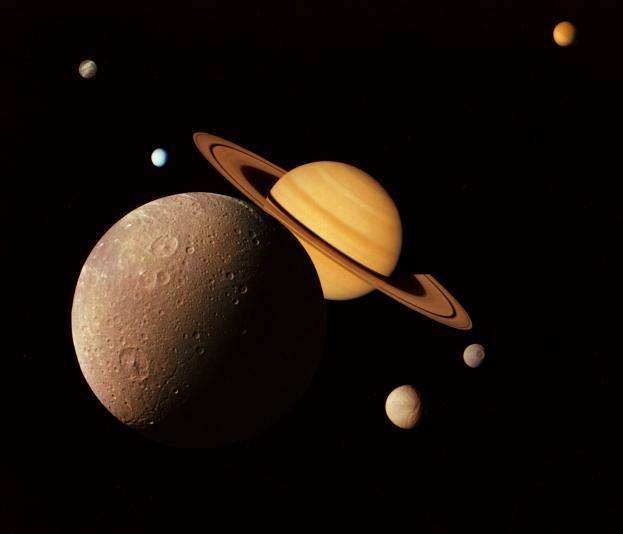
Saturn is well known for being a gas giant, and for its impressive ring system. But it would it surprise you to know that this planet also has the second-most moons in the solar system, second only to Jupiter? Yes, Saturn has at least 150 moons and moonlets in total, though only 53 of these moons have been given official names.
Most of these moons are small, icy bodies that are little more than parts of its impressive ring system. In fact, 34 of those moons that have been named are less than 10 km in diameter, and another 14 are between 10 and 50 km in diameter. However, some of its inner and outer moons are among the largest and most dramatic in the solar system, ranging from 250 to over 5000 km.
Traditionally, most of Saturn's moons have been named after the Titans of Greek mythology, and are grouped based on their size, orbits, and proximity to Saturn. The innermost moons and regular moons all have small orbital inclinations and eccentricities and prograde orbits. Meanwhile, the irregular moons in the outermost regions have orbital radii of millions of kilometers, orbital periods lasting several years, and move in retrograde orbits.
Inner Large Moons:
Saturn's Inner Large Moons, which orbit within the E Ring (see below), includes the larger satellites Mimas, Enceladus, Tethys, and Dione. These moons are all composed primarily of water ice, and are believed to be differentiated into a rocky core and an icy mantle and crust. With a diameter of 396 km and a mass of 0.4×1020 kg, Mimas is the smallest and least massive of these moons. It is ovoid in shape and orbits Saturn at a distance of 185,539 km with an orbital period of 0.9 days.
Enceladus, meanwhile, has a diameter of 504 km, a mass of 1.1×1020 km and is spherical in shape. It orbits Saturn at a distance of 237,948 km and takes 1.4 days to complete a single orbit. Though it is one of the smaller spherical moons, it is the only Cronian moon that is endogenously active – and one of the smallest known bodies in the solar system that is geologically active. This results in features like the famous "tiger stripes" – a series of continuous, ridged, slightly curved and roughly parallel faults within the moon's southern polar latitudes.
Large geysers have also been observed in the southern polar region that periodically release plumes of water ice, gas and dust which replenish Saturn's E ring. These jets are one of several indications that Enceladus has liquid water beneath it's icy crust, where geothermal processes release enough heat to maintain a warm water ocean closer to its core. With a geometrical albedo of more than 140%, Enceladus is one of the brightest known objects in the solar system.
At 1066 km in diameter, Tethys is the second-largest of Saturn's inner moons and the 16th-largest moon in the solar system. The majority of its surface is made up of heavily cratered and hilly terrain and a smaller and smoother plains region. Its most prominent features are the large impact crater of Odysseus, which measures 400 km in diameter, and a vast canyon system named Ithaca Chasma – which is concentric with Odysseus and measures 100 km wide, 3 to 5 km deep and 2,000 km long.
With a diameter and mass of 1,123 km and 11×1020 kg, Dione is the largest inner moon of Saturn. The majority of Dione's surface is heavily cratered old terrain, with craters that measure up to 250 km in diameter. However, the moon is also covered with an extensive network of troughs and lineaments which indicate that in the past it had global tectonic activity.
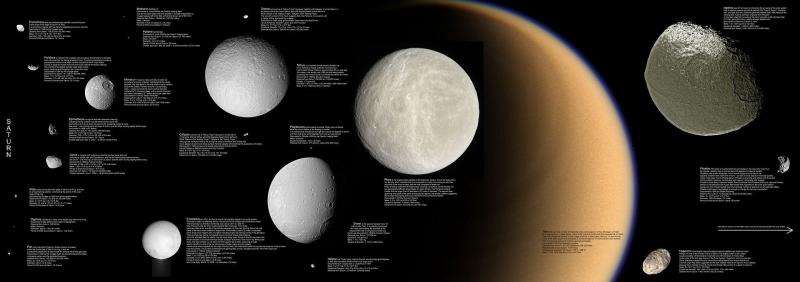
Large Outer Moons:
The Large Outer Moons, which orbit outside of the Saturn's E Ring, are similar in composition to the Inner Moons – i.e. composed primarily of water ice and rock. Of these, Rhea is the second largest – measuring 1,527 km in diameter and 23×1020 kg in mass – and the ninth largest moon of the solar system. With an orbital radius of 527,108 km, it is the fifth-most distant of the larger moons, and takes 4.5 days to complete an orbit.
Like other Cronian satellites, Rhea has a rather heavily cratered surface, and a few large fractures on its trailing hemisphere. Rhea also has two very large impact basins on its anti-Saturnian hemisphere – the Tirawa crater (similar to Odysseus on Tethys) and an as-yet unnamed crater – that measure 400 and 500 km across, respectively.
At 5150 km in diameter, and 1,350×1020 kg in mass, Titan is Saturn's largest moon and comprises more than 96% of the mass in orbit around the planet. Titan is also the only large moon to have its own atmosphere, which is cold, dense, and composed primarily of nitrogen with a small fraction of methane. Scientists have also noted the presence of polycyclic aromatic hydrocarbons in the upper atmosphere, as well as methane ice crystals.
The surface of Titan, which is difficult to observe due to persistent atmospheric haze, shows only a few impact craters, evidence of cryo-volcanoes, and longitudinal dune fields that were apparently shaped by tidal winds. Titan is also the only body in the solar system beside Earth with bodies of liquid on its surface, in the form of methane–ethane lakes in Titan's north and south polar regions.
With an orbital distance of 1,221,870 km, it is the second-farthest large moon from Saturn, and completes a single orbit every 16 days. Like Europa and Ganymede, it is believed that Titan has a subsurface ocean made of water mixed with ammonia, which can erupt to the surface of the moon and lead to cryovolcanism.
Hyperion is Titan's immediate neighbor. At an average diameter of about 270 km, it is smaller and lighter than Mimas. It is also irregularly shaped and quite odd in composition. Essentially, the moon is an ovoid, tan-colored body with an extremely porous surface (which resembles a sponge). The surface of Hyperion is covered with numerous impact craters, most of which are 2 to 10 km in diameter. It also has a highly unpredictable rotation, with no well-defined poles or equator.
At 1,470 km in diameter and 18×1020 kg in mass, Iapetus is the third-largest of Saturn's large moons. And at a distance of 3,560,820 km from Saturn, it is the most distant of the large moons, and takes 79 days to complete a single orbit. Due to its unusual color and composition – its leading hemisphere is dark and black whereas its trailing hemisphere is much brighter – it is often called the "yin and yang" of Saturn's moons.
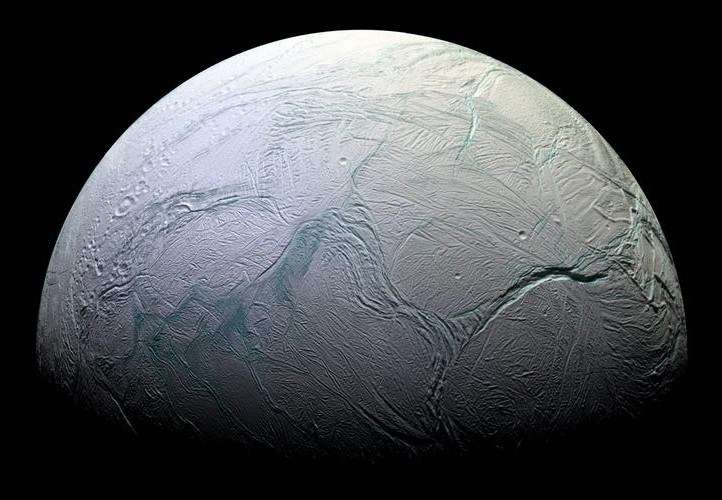
Irregular Moons:
Beyond these larger moons are Saturn's Irregular Moons. These satellites are small, have large-radii, are inclined, have mostly retrograde orbits, and are believed to have been acquired by Saturn's gravity. These moons are made up of three basic groups – the Inuit Group, the Gallic Group, and the Norse Group.
The Inuit Group consists of five irregular moons that are all named from Inuit mythology – Ijiraq, Kiviuq, Paaliaq, Siarnaq, and Tarqeq. All have prograde orbits that range from 11.1 to 17.9 million km, and from 7 to 40 km in diameter. They are all similar in appearance (reddish in hue) and have orbital inclinations of between 45 and 50°.
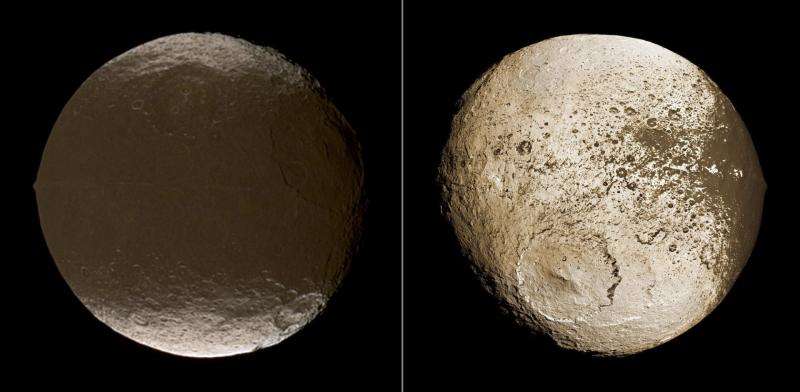
The Gallic group are a group of four prograde outer moons named for characters in Gallic mythology -Albiorix, Bebhionn, Erriapus, and Tarvos. Here too, the moons are similar in appearance and have orbits that range from 16 to 19 million km. Their inclinations are in the 35°-40° range, their eccentricities around 0.53, and they range in size from 6 to 32 km.
Last, there is the Norse group, which consists of 29 retrograde outer moons that take their names from Norse mythology. These satellites range in size from 6 to 18 km, their distances from 12 and 24 million km, their inclinations between 136° and 175°, and their eccentricities between 0.13 and 0.77. This group is also sometimes referred to as the Phoebe group, due to the presence of a single larger moon in the group – which measures 240 km in diameter. The second largest, Ymir, measures 18 km across.
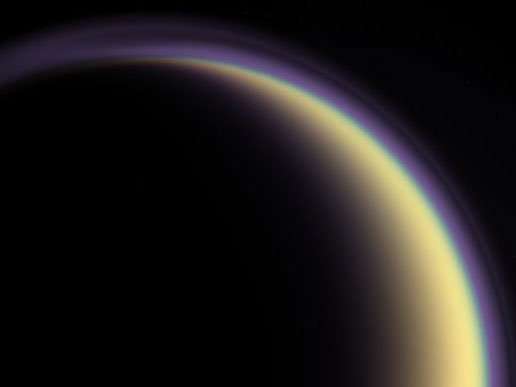
Within the Inner and Outer Large Moons, there are also those belonging to Alkyonide group. These moons – Methone, Anthe, and Pallene – are named after the Alkyonides of Greek mythology, are located between the orbits of Mimas and Enceladus, and are among the smallest moons around Saturn.
Some of the larger moons even have moons of their own, which are known as Trojan moons. For instance, Tethys has two trojans – Telesto and Calypso, while Dione has Helene and Polydeuces.
Much like Jupiter, and all the other gas giants, Saturn has an extensive system of moons. In addition to the larger ones that formed from the massive deris field that orbits it, it also has countless smaller satellites that were captured by its gravitational field over the course of billions of years. One can only imagine how many more remain to be found orbiting the ringed giant.
-
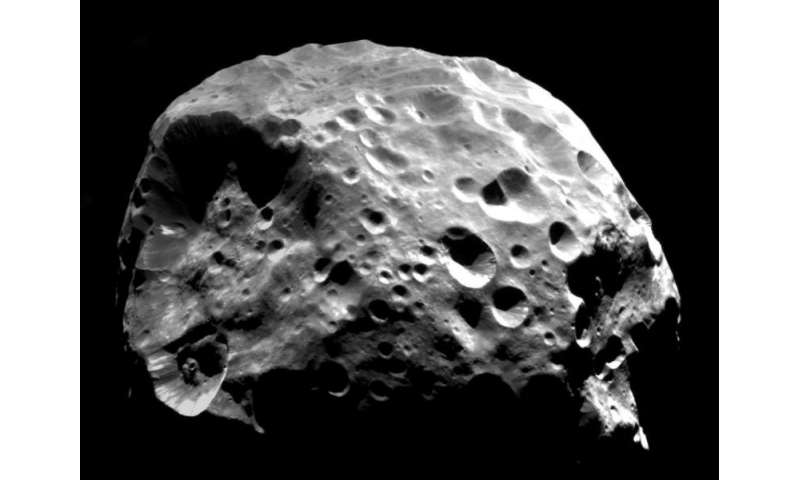
Saturn’s comet moon Phoebe. Credit: NASA/JPL -
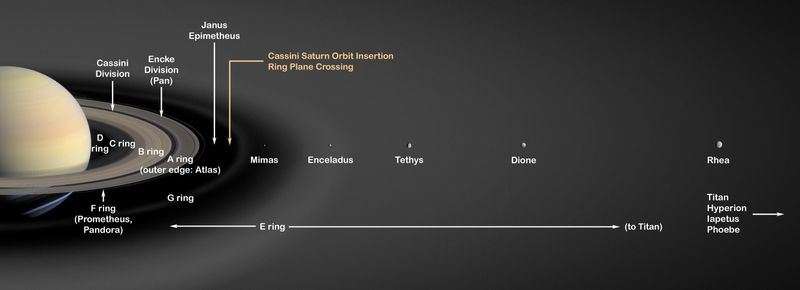
Saturn’s rings and moons Credit: NASA
Source: Universe Today





















